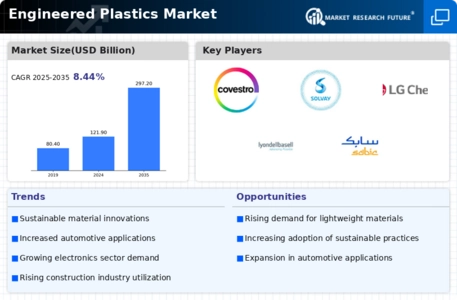Market Trends
Key Emerging Trends in the Engineered Plastics Market
The Engineered Plastics Market has seen significant trends lately, which demonstrate the ever-changing nature of the plastics industry. High-performance plastics are also known as engineered plastics, which are polymers with improved physical, thermal, or chemical features. One of them is the increasing demand for lightweight and strong materials across many sectors that have gained prominence. Sustainability also plays an important role in shaping market trends. It's being demanded more and more that such engineered plastic should be recyclable materials with small carbon footprints because consumer minds have become conscious of environmental degradation and climate change mitigation. There are thus efforts amongst manufacturers to come up with innovative materials that not only meet performance requirements but also comply with sustainable practices. As this happens, stringent legislation aimed at reducing plastic waste is driving it. The next trend involves the application of engineered plastics in the healthcare sector. Engineered plastics have gained importance in this industry due to their ability to provide material for medical devices that need certain properties like biocompatibility, sterilizability, or chemical resistance as they improve their sophistication levels. Globalization is yet another significant factor when it comes to market trends today, alongside technological changes currently taking place within our society. The increased interconnectivity between economies has facilitated the exchange of technologies and production processes, leading to large-scale production of engineering plastics at lower costs, hence making them more accessible in various applications and industries. Further, still under the market trends section, customization is turning out to be a key aspect for consideration by businesses operating in different markets within the globe. Engineered plastics can now be fine-tuned to fit the specifications of a certain design by incorporating advanced manufacturing techniques like 3D printing. This level of customization improves product performance and also opens up new possibilities in terms of design and functionality across different sectors. However, fluctuations in raw material prices and prevailing global economic uncertainties have affected the Engineered Plastics Market, thus creating challenges for this market. It is, therefore, important for manufacturers to strategize on how they can remain competitive and, at the same time, grow sustainably in such a market. At the same time, there is increased competition within the industry that has come with companies having to differentiate themselves through product innovation as well as maintaining high-quality standards and efficient supply chain management.









Leave a Comment